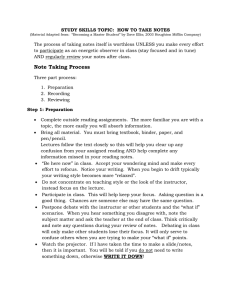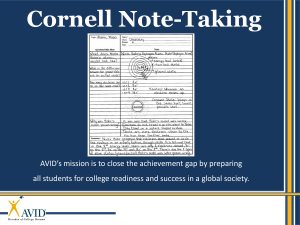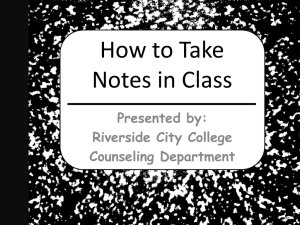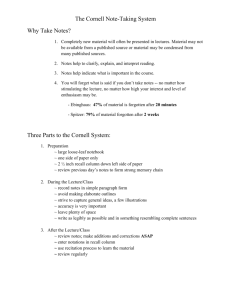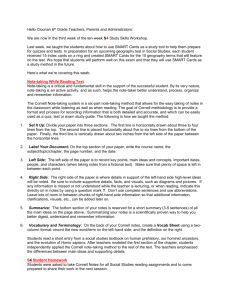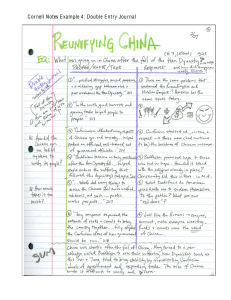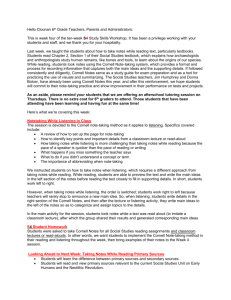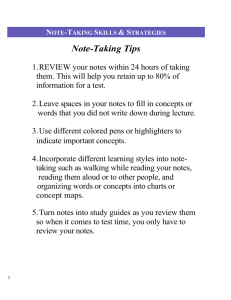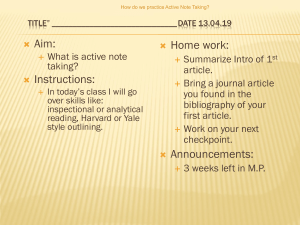Focused Note Taking
advertisement
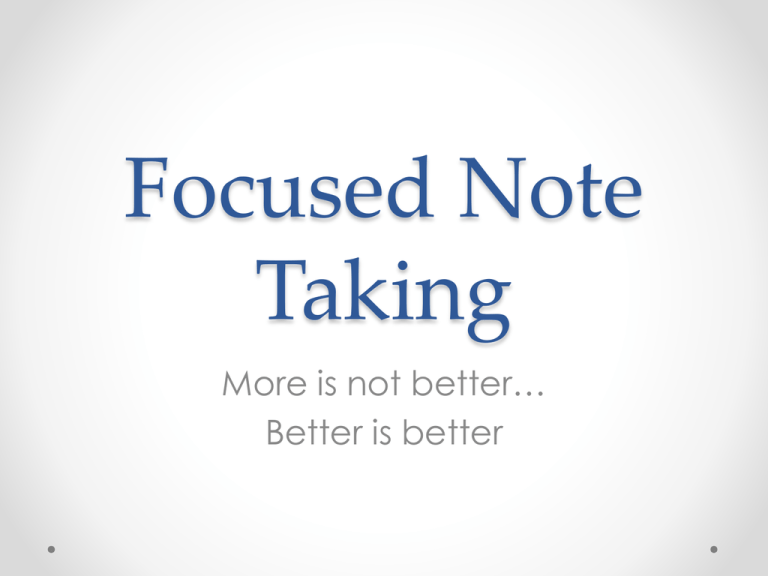
Focused Note Taking More is not better… Better is better Why take notes? Partner discussion: • Why do we have students take notes? Why take notes? Just a study tool that we hope works? Or, can note taking be an effective method for long-term memory retention and an catalyst for increased learning and achievement? Some Questions to Think About… • Do students know HOW to take effective notes? • Do students know how to USE notes? • How can notes be most effectively used to retain relevant information? o Do I know that? o Do my students know that? • What does the research say about effective uses of note taking? The Curve of Forgetting The Curve of Forgetting describes how we retain or get rid of information that we take in. It's based on a one-hour lecture. • Notes without review: 97% information loss after 30 days • Notes with daily review: >80% information in long-term memory As teachers, we cannot assume that our students are effective note takers and know how to effectively use their notes for learning. Effective note taking needs to be explicitly taught and practiced with students. More importantly, because of a block schedule, effective note taking, note interacting and note review becomes all the more important because of the greater amount of time between class sessions. Note Taking Note Reflecting Four Areas of Effective Note Taking Note Interacting Note Making Note Taking Note Reflecting Four Areas of Effective Note Taking Note Interacting Note Making Increased Student Learning and Achievement The Cornell Way Ten Steps in the Cornell Note Taking System The Essential Question… Student created, higher level questions Heading Notes Section Cornell Notes Notes Summary Part I: Note-Taking Step One: Create Format • Leave 1/3 of the paper on the left for questions, 2/3 on the right for notes • Leave 2 inches on the bottom of each page for summary • Create an essential question based on the learning target to be addressed in the notes and in the summary Part I: Note-Taking Step Two: Organize Notes on the Right Side of Your Note Paper • Take notes while listening to a lecture, reading a textbook, solving a math problem, etc. • Listen and take notes in your own words – paraphrase what you hear • Write in phrases, not complete sentences • Know what to write – differentiate between important information vs. trivial information Part II: Note-Making Step 3: Review and Revise Notes • Distinguish main ideas from details • Categorize information by highlighting or color coding • Delete unimportant information • Add your own thinking – fill in details to clarify, complete, or create greater meaning and understanding • Identify unclear information by using a question mark • Add references from other materials as they come to mind or make connections to other concept/content • Review for possible paper topics or test questions Part II: Note-Making Step 4: Note Key Ideas to Create Questions • Write questions on the left side of your notes page that connect to key ideas • Review the main ideas highlighter on the right side Part II: Note-Making Step 5: Exchange Ideas by Collaborating • Collaborate with a peer(s), as a small group, as a whole class, outside of class, etc. to compare, enhance, and revise your notes • Fill in any gaps and clarify points of confusion • Brainstorm a list of key terminology from the lesson to be included in the summary Part III: Note-Interacting Step 6: Link Learning to Create a Summary • Identify the main ideas to be used in the summary by reviewing your notes, questions written on the left side, and prior knowledge • Address the essential question of the lesson in the summary • Use the notes on the right side for support as you write the summary • Combine main ideas by synthesizing; internalize learning from the questions/notes • Answer the higher level questions on the left side in the summary to tie together the main ideas Part III: Note-Interacting Step 7: Learning Tool – Use Completed Notes as a Learning Tool • Review notes taken, questions developed, and the summary, individually or with a study group • Apply new learning to increase performance in the class by using notes to study for a test, write an essay, prepare for a presentation, etc. • Interact with material by taking notes, writing questions, and summarizing to internalize the information and increase subsequent learning • Use the notes to transfer knowledge to long-term memory by forming connections with and making meaning of the notes Part IV: Note-Reflecting Step 8: Written Feedback • Review, revise, and improve notes, questions, and summary based on feedback by a peer or instructor • Use the feedback to check for quality Part IV: Note-Reflecting Step 9: Address Written Feedback • Create a goal for improving future note-taking • Use the feedback provided to identify an aspect of note taking that challenges you • Identify specific actions to address this challenge in future note taking Part IV: Note-Reflecting Step 10: Your Reflection • Review your notes, questions and summaries, then reflect on your learning by completing a reflective log to show how you mastered and/or applied your new knowledge Using 90 Minutes Effectively 10-2-2 Note Taking Structure 10-2-2 Structure & Rationale: • The structure involves the following: o 10 minutes: presenting information/note-taking o 2 minutes: Processing information o 2 minutes: Summarizing information • Allows students the necessary time to process information and concepts presented in whole group instruction • The structure allows for: o Greater retention of information o Improvement in the quality of notes, question, and summaries 10 Minutes: Whole Group Instruction • The instructor lectures/presents information or gives and audio-visual presentation for ten minutes while the students take Cornell notes. • Encourage students to use abbreviations and short-cuts while taking notes. 2 Minutes: Partners/Small Groups • The instructor then pauses for two minutes while the students take time to process the information by working collaboratively in partners/small groups to do the following: o o o o o Sharing notes Revising/refining notes Filling in gaps in notes Clarify information/concepts presented Create questions on the left side • During this time students are not allowed to ask the instructor questions; students should rely on the support of peers to assist them in processing the information. 2 Minutes: Independently • The students then take two minutes silently to individually process the information and create a one-sentence summary to be placed across the page just below the chunk of notes. • The teacher may choose to have students share out their sentence summary as a way to check for understanding. Repeat the Process • Repeat the process until all information is presented. Last 5 Minutes: Whole Group • Reserve the last five minutes of the lesson for the students to interact with the teacher. • Students can ask questions to: o Resolved unanswered questions o Get clarification about information presented o Sort out misconceptions/gaps Effective Note Taking as a Strategy in a 90 Minute Block... • Review of previous information is critical o Many of the steps in the Cornell Way would be excellent class activities • Breakup the note taking process o Give students opportunity to process the information in an effective way o Don’t blab on and on; give students a chance to learn • Teaching Content vs. Facilitating Learning o Students needs to take ownership of what is being delivered in class o Effective note taking, such as the Cornell Way, forces students to take greater ownership and accountability in their own learning
